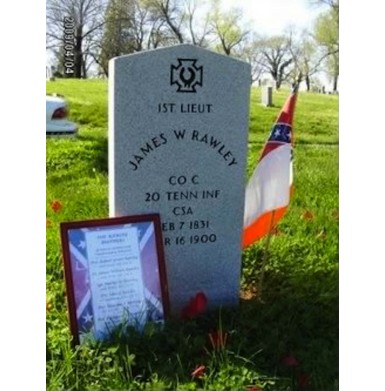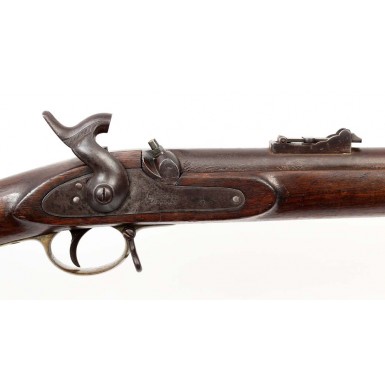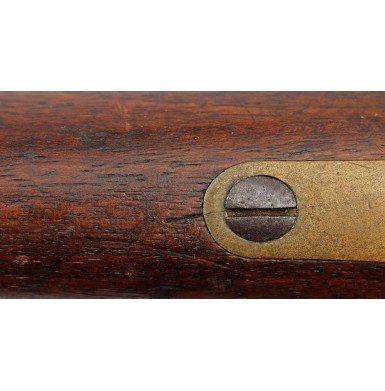ID'd CS Enfield - JW Rawley - 20th TN Infantry
- Product Code: FLA-2074-SOLD
- Availability: Out Of Stock
-
$1.00
It is not often that I have the opportunity to offer for sale, an item that I consider to be an iconic Civil War artifact. Offered here is an identified P-1853 Enfield Rifle Musket by the arms maker to the Confederacy, John Edward Barnett & Sons, complete with a Confederate viewer’s mark. The gun has a wonderful period carved name in the stock flat, opposite the lock, which reads J W RAWLEY. James W. Rawley was a member of one of the most famous and hard fighting of all Confederate Infantry regiments, the 20th Tennessee Volunteer Infantry CSA. While it would take pages to adequately describe the history of this storied regiment, a quick summary of their service is in order. The 20th TN Infantry was one of the very few regiments in Confederate service to fight from the very beginning of the war to the very end. They assembled at Camp Trousdale in May and June of 1861 as part of the Provisional Army of Tennessee, and the 880 members of the regiment mustered into Confederate service in July of that year. The 20th saw their first major action at the battle of Fishing Creek (aka Mill Springs) in Kentucky, on January 19, 1862. They suffered 110 casualties during the battle. They were at a great disadvantage during that engagement, as they were armed with flintlock muskets and the torrential rains rendered the guns practically useless. The regiment’s 2nd in command, Lt. Colonel B. Moscow Carter (his family owned the “Carter House” in Franklin, TN) was captured in the battle. After the debacle at Fishing Creek, the regiment regrouped in Murfreesboro, TN and then proceeded to Iuka, MS, from which they advanced into Tennessee and took part in the Battle of Shiloh on April 6 & 7, 1862. On April 3, just days before the battle, the regiment was issued new Enfield Rifle Muskets, while in Burnsville, MS. The regimental historians related the story this way, in their history of the 20th, which was published in 1904:
“While at Burnsville, only a few days before the battle of Shiloh, the Twentieth Tennessee Regiment drew new Enfield rifles with new accoutrements and English ammunition, and if there was ever a body of men that appreciated a good thing it was this regiment, for they had experienced the inferiority of their arms to that of the enemy on the battle field of Fishing Creek.”
The 20th suffered some 187 casualties at Shiloh, out of approximately 400 men engaged. Following the battle, the regiment went through a major reorganization due to the significant losses. The regiment was sent to Vicksburg in May of 1862 and served there are part of General Van Dorn’s Army through August of that year, when they were sent to Louisiana, and served in the Baton Rouge and Port Hudson area. In September of 1862 they were transferred back to the Army of Tennessee, and took part in the battle of Murfreesboro (Stones River) from December 31, 1862 through January 2, 1863, where the regiment suffered 118 casualties. The regiment wintered in the Tullahoma, TN area after the battle with the majority of the Army of Tennessee. It also spent some time in Wartrace, TN and took part in the Tullahoma campaign during the spring and summer of 1863. They participated in the battle of Hoover’s Gap on June 23, 1863. There they came face to face with General Wilder’s “Lighting Brigade”, which was armed with Spencer Rifles. Following the withdrawal towards Chattanooga, the 20th was engaged at the battle of Chickamauga. By then the beleaguered regiment could only engage 183 men, of which 88 became causalities. Following the battle, the regiment withdrew to the heights outside of Chattanooga and participated in the battle of Missionary Ridge on November 25, 1863. In 1864, the regiment participated in the Atlanta Campaign, and fought at all of the well known engagements of that tactical withdrawal, including Rocky Face Gap, Resaca, New Hope Church, Pine Mountain, Kennesaw Mountain, Peach Tree Creek and Jonesboro. After the disastrous loss of Atlanta, the regiment participated in the capture of the blockhouse in Dalton, GA (October 13, 1864), and then crossed back into Tennessee on November 13, 1864 to take part in Hood’s even more disastrous Tennessee Campaign. The 20th fought at the battle of Franklin on November 30, 1864. After the battle the 2nd, 10th, 20th, 30th and 37th TN infantry regiments were consolidated, and the current colonel of the 20th TN, William Shy was given command. During the battle of Nashville the remains of the 20th fought valiantly on the hill in Nashville that now bears the name of their Colonel, but could not defend “Shy’s Hill” from the Yankee onslaught. The remains of the unit crossed the Tennessee River on December 24, 1864 and proceeded to North Carolina, where the skeleton of the Army of Tennessee joined General Joe Johnston’s command. After 4 years of fighting the 20th TN (which started the war with an initial strength of 880 officers and men) was reorganized for the last time on April 9, 1865 as part of the 4th Consolidated Tennessee Infantry Regiment. At that time they fielded only 34 men. On May 1, 1865, with the Confederate surrender at Greensboro, NC, the 20th Tennessee Volunteer Infantry ceased to exist completely. It is hard to find any Confederate regiment that fought the war from the beginning to the end, and could field only 3% of its original strength at the end. The 20th Tennessee Volunteer Infantry could be the poster child for the “lost cause of the Confederacy”.
James W Rawley of Nashville, TN was born on Turkey Creek in Smith County, TN on February 7, 1831. According to his tombstone, recently installed in the Mount Olivet Cemetery in Nashville, TN, he died on March 16, 1900. However, the regimental history of the 20th TN notes that he died in Nashville in 1896. His family operated Rawley & Brothers - Dry Goods & Clothing in Nashville, prior to the war. He was one of six brothers who all fought for the Confederacy during the war. The six Rawley brothers saw service in the 8th, 11th & 20th TN Infantry Regiments, the 1st AL Cavalry and the 2nd TX Infantry! J.W. Rawley enlisted in Company C of the 20th TN Infantry on May 20, 1861 for a period of 12 months. That enlistment was subsequently changed to three years. Company C of the 20th was noted in the regimental history to be the third best company in the regiment and was given the honor as serving as the color company in the center of the regimental line. Following the battle of Shiloh, Rawley was promoted to the rank of 1st Lieutenant of Company C, and served in that capacity for one day short of a year. On May 14, 1863, at the Battle of Resaca, Lt. Rawley was seriously wounded. The following anecdote about Lt. Rawley’s wound was found in the 1904 publication History of the Twentieth Tennessee Regiment Volunteer Infantry, C.S.A. by William Josiah McMurray, Deering J. Roberts & Ralph J. Neal.
“At the battle of Resaca, the 20th was crowded in behind some little earthworks, every one trying to protect himself as best he could. John Savage, and Lieut. Jas. Rawley, who had previously had some differences and had not spoken to each other for six months, were piled in together. John Savage’s head was laying on Lieut. Rawley’s hip, when a shell exploded right at them and took John Savage’s head off and drove his old white hat into a black gum log, and tore about three pounds of flesh from Lieut. Rawley’s hip from which he never recovered, so just before death they made friends, only to be separated forever. Such is war!”
Lt. Rawley spent the rest of the war in various hospitals and never fully recovered from his wounds. According to research done by his descendants, he married around 1870 in Bowling Green, KY and had two children. As noted earlier, his date of death is in some dispute, but his decedents place it in March of 1900. Lt. Rawley was buried in Mt. Olivet Cemetery in Nashville; in an unadorned grave, and in 2008 his descendants placed the current marker on his cemetery plot. Numerous copies of Rawley’s service records, records relating to the 20th TN and a picture of his grave marker are included with his gun.
The gun of James W Rawley is a classic example of a Confederate purchased Enfield. It is a C H / 1 marked P-1853 Enfield rifle musket manufactured by the famous London based Barnett company. This gun was most likely issued to Private J. W. Rawley in Burnsville, MS on or about April 3, 1861. Rarely can we pin down the time and place that a Confederate weapon was issued, but the historians for the 20th TN were nice enough to mention the event in their regimental history. The gun is marked with the Confederate viewer’s mark CH / 1. Initially this mark was thought to refer to Confederate purchasing agent Caleb Huse, but documents contained in the McRae papers clearly indicate that the mark really refers to arms viewers (inspectors) Curtis & Hughes who were hired by S. Isaac Campbell & Company to inspect arms that had been purchased for the Confederacy. Contained within those papers is an inspection certification dated September 26, 1861, on which Isaac Curtis attests to his viewing of 75 “2nd Hand” P-1851 Mini” Rifles. Clearly the viewers inspected many more arms than those, and this mark is known on Confederate imported P-1853 rifle muskets and Brunswick rifles of Confederate provenance as well. The CH/1 mark is most often encountered on British arms made by (or sold by) Barnett. Another invoice within the McRae papers was sent to John Edward Barnett & Sons on May 26, 1862 for the sum of “46.17s.2d to pay for the viewing services of “Curtis & Hughes’ who had inspected guns delivered by Barnett.
The Barnett family traced their unmaking heritage to Thomas Barnett who operated in London as early as 1796. In 1811 the firm became Thomas Barnett & Sons, and John Edward Barnett subsequently succeeded to the business in 1833. In 1842 the firm was renamed JE Barnett & Sons and operated under that name until 1901 when they became JE Barnett & Sons LTD, going out of business in 1908. During the Civil War years, the Barnett’s operated at both their 134 Minories address which had been established in 1833 and at Brewhouse Lane, Wapping, where they operated from 1860-1874. Barnett can reasonably be called England’s “Gun Maker to the Confederacy”, as they not only filled Confederate central government contracts, but also those of the Confederates states Georgia, North Carolina, and South Carolina. In the typical fashion of old time gunmakers in England, Barnett relied on a variety of contractors to produced piece work parts which were subsequently assembled into complete arms in the Barnett shop. While Barnett could clearly manufacture entire guns in house, it was often more expedient and cost effective to sub-contract for major components when large contracts were received. In the case of this rifle musket, although the lock is marked both on the exterior and interior “BARNETT”, the interior is also marked by its actual maker J. BRAZIER. The exterior of the guns lock is simply marked BARNETT / LONDON forward of the hammer. The barrel is marked with standard London commercial proofs, and the gun is devoid of any British military markings. The Confederate C H / 1 mark is located in a circle roughly ““ in diameter, and is stamped about ““ forward of the buttplate tang on the top of the stock. The mark is only partially visible with the naked eye and is rather difficult to photograph. Without a glass the circle is about 50% visible, and the CH / 1 mark is only partially visible. Under a glass the “H” is quite clear, the “1” somewhat less clear and the “C” is mostly gone. The gun is in about VERY GOOD+ to NEAR FINE condition overall, especially for a Confederate imported rifle musket that certainly saw use during a good portion of at least the first half of the war. There is strong documentation that many of the CH / 1 marked guns shipped from England to Nassau (Bahamas) via the Confederate cargo ship Gladiator, which left England on November 10, 1861. The ship unloaded in the Bahamas and its cargo was transshipped via smaller Blockade Running vessels. The Blockade Runner Kate subsequently left Nassau on January 30, 1862 and delivered 6,000 Enfields from the Gladiator cargo to Smyrna, FL. Many of these arms were then shipped by wagon, rail and riverboat to Albert Sydney Johnston’s Army of Tennessee, with the majority of the guns arriving in Burnsville, MS on April 3!
The gun shows real use, with some light flash pitting present around the breech and bolster area. The metal of the gun has a nice, untouched plum-brown patina that is somewhat mottled. The metal is mostly smooth forward of the rear site, with some scattered areas of peppering and pinpricking, and most of the minor roughness confined to the breech area, as previously mentioned. The bore is in about VERY GOOD+ condition as well. The bore is relatively bright, but is dirty and shows some scattered light pitting along its length, with strong rifling the full length of the barrel. The gun retains both of the original sling swivels, as well as the original long-range rear sight and the front sight / bayonet lug. The original, full-length ramrod is present under the barrel and retains portions of the original threads. The barrel bands also retain their original “doughnut” screw keepers on their ends. The lock functions perfectly on all positions, and the action remains crisp. The brass furniture has a nice, untouched bronze patina that is quite attractive. The stock is in VERY GOOD+ to NEAR FINE condition as well. The name J W RAWLEY is carved in the flat of the stock, opposite the lock, in a lovely period hand. The stock is full-length and without breaks, cracks or repairs noted. There are the usual array of bumps, dings and mars over the length of the stock, as would be expected of any military long arm that saw actual use in the field. There are a couple of minor chips of wood missing, the most notable being a small sliver missing between the rear of the left breech and the barrel tang, which is less the ““ in length and just under ““ in width. Other minor mars are a couple of stock scrapes that do penetrate the finish of the wood, but are hardly significant and should be quite visible in the pictures below. None of the minor stock mars are significant, and none detract from the display of this wonderful Confederate weapon.
Rarely do high condition Confederate marked Enfields appear on the market with such wonderful provenance and identifications. Even more rare is a gun that we can almost certainly place on specific Blockade Runners and even establish where and when it was issued! The story of the 20th TN Infantry and that of Private then Lieutenant James W. Rawley is truly compelling. It is not clear whether Rawley carried his rifle through his wounding at Resaca (it was not uncommon for junior Confederate officers to carry a long arm) or whether he gave it up in May of 1862 when he was promoted. The gun was initially discovered in Georgia many years ago, so it seems likely that he may have had it with him when he was so grievously injured at Resaca. One way or the other, this is really a fantastic Confederate Enfield that has ties to some of the greatest battles of the Western Theater, from Shiloh to Chickamauga, to Franklin and to the desperate defense of Shy’s Hill in Nashville. This gun was there to see the dreams of the Confederacy flower under Albert Sydney Johnston and die under John Bell Hood. Rarely do I feel so moved by a piece of Civil War history, but for any collector who has a real interest in the Civil War in Tennessee, this gun has everything you could possibly want. It was issued just before Shiloh and even has an indirect association (thought the regiment) to such iconic places as Shy’s Hill and the Carter House. It may have even been at those battles after Resaca, in the hands of a different Confederate soldier, but sadly as the gun cannot talk, we will probably never know. This is a gun that absolutely deserves to be the centerpiece of a really advanced Confederate collection and is a piece that I am sure I will be sorry that I did not keep. Approximately 100 pages of digital copies of period service records for Rawley and the 20th TN will be included with the gun.
SOLD








